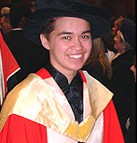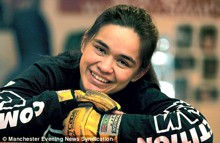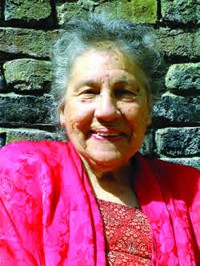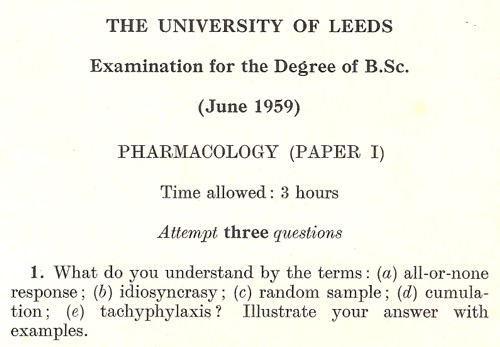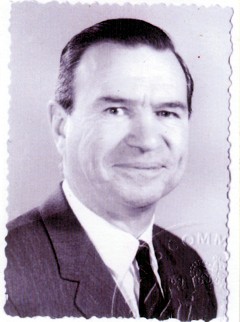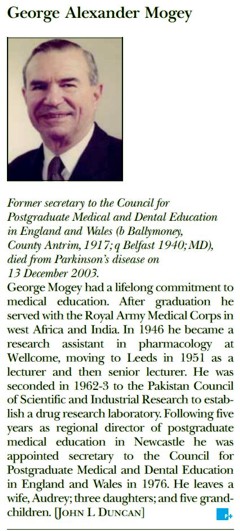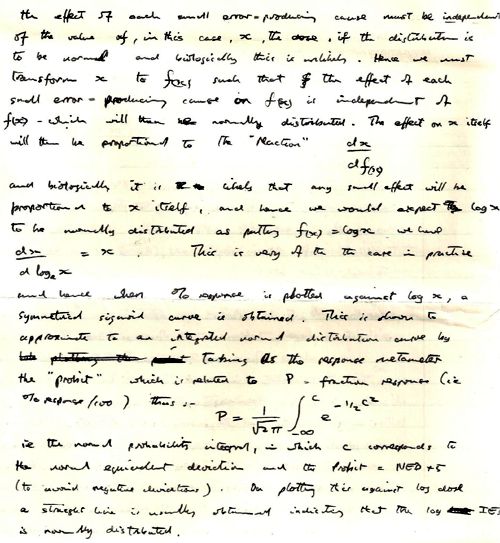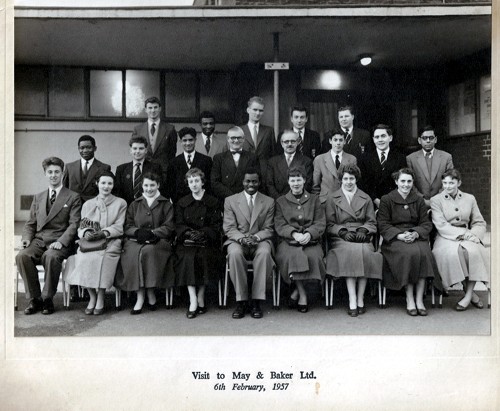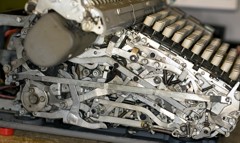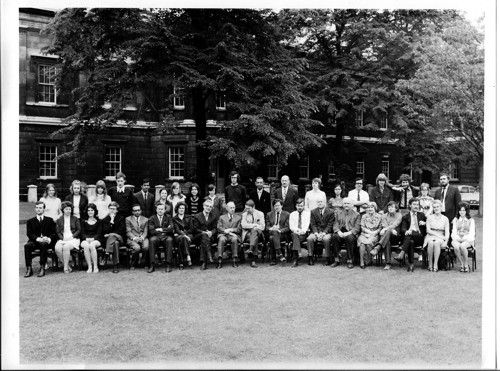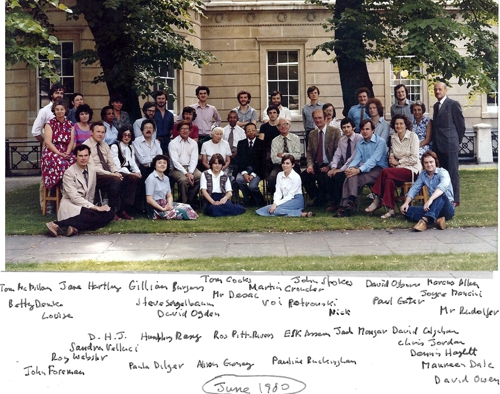University College London
See also The history of eugenics at UCL: the inquiry report.
On Monday evening (8th January 2018), I got an email from Ben van der Merwe, a UCL student who works as a reporter for the student newspaper, London Student. He said
“Our investigation has found a ring of academic psychologists associated with Richard Lynn’s journal Mankind Quarterly to be holding annual conferences at UCL. This includes the UCL psychologist professor James Thompson”.
He asked me for comment about the “London Conference on Intelligence”. His piece came out on Wednesday 10th January. It was a superb piece of investigative journalism. On the same day, Private Eye published a report on the same topic.
I had never heard about this conference, but it quickly became apparent that it was a forum for old-fashioned eugenicists of the worst kind. Perhaps it isn’t surprising that neither I, nor anyone else at UCL that I’ve spoken to had heard of these conferences because they were surrounded by secrecy. According to the Private Eye report:
“Attendees were only told the venue at the last minute and asked not to share the information”
The conference appears to have been held at least twice before. The programmes for the 2015 conference [download pdf] and the 2016 conference [download pdf] are now available, but weren’t public at the time. They have the official UCL logo across the top despite the fact that Thompson has been only an honorary lecturer since 2007.

A room was booked for the conference through UCL’s external room booking service. The abstracts are written in the style of a regular conference. It’s possible that someone with no knowledge of genetics (as is likely to be the case for room-booking staff) might have not spotted the problem.
The huge problems are illustrated by the London Student piece, which identifies many close connections between conference speakers and far-right, and neo-nazi hate groups.
“[James Thompson’s] political leanings are betrayed by his public Twitter account, where he follows prominent white supremacists including Richard Spencer (who follows him back), Virginia Dare, American Renaissance, Brett Stevens, the Traditional Britain Group, Charles Murray and Jared Taylor.”
“Thompson is a frequent contributor to the Unz Review, which has been described as “a mix of far-right and far-left anti-Semitic crackpottery,” and features articles such as ‘America’s Jews are Driving America’s Wars’ and ‘What to do with Latinos?’.
His own articles include frequent defences of the idea that women are innately less intelligent than men (1, 2, 3,and 4), and an analysis of the racial wage gap which concludes that “some ethnicities contribute relatively little,” namely “blacks.”
“By far the most disturbing of part of Kirkegaard’s internet presence, however, is a blog-post in which he justifies child rape. He states that a ‘compromise’ with paedophiles could be:
“having sex with a sleeping child without them knowing it (so, using sleeping medicine. If they don’t notice it is difficult to see how they cud be harmed, even if it is rape. One must distinguish between rape becus the other was disconsenting (wanting to not have sex), and rape becus the other is not consenting, but not disconsenting either.”
The UCL Students’ Union paper, Cheesegrater, lists some of James Thompson’s tweets,including some about brain size in women.
Dr Alice Lee
It’s interesting that these came to light on the same day that I learned that the first person to show that there was NO correlation between brain size and intelligence was Dr Alice Lee, in 1901: A First Study of the Correlation of the Human Skull. Phil. Trans. Roy. Soc A https://doi.org/10.1098/rsta.1901.0005 [download pdf].
 Alice Lee published quite a lot, much of it with Pearson. In 1903, for example, On the correlation of the mental and physical characters in man. Part II Alice Lee, Marie A. Lewenz and Karl Pearson https://doi.org/10.1098/rspl.1902.0070 [download pdf]. She shows herself to be quite feisty in this paper -she says of a paper with conclusions that differs from hers
Alice Lee published quite a lot, much of it with Pearson. In 1903, for example, On the correlation of the mental and physical characters in man. Part II Alice Lee, Marie A. Lewenz and Karl Pearson https://doi.org/10.1098/rspl.1902.0070 [download pdf]. She shows herself to be quite feisty in this paper -she says of a paper with conclusions that differs from hers
“Frankly, we consider that the memoir is a good illustration of how little can be safely argued from meagre data and a defective statistical theory.”
She also published a purely mathematical paper, “On the Distribution of the Correlation Coefficient in Small Samples”, H. E. Soper, A. W. Young, B. M. Cave, A. Lee and K. Pearson, Biometrika, 11, 1917, pp. 328-413 (91 pages) [download pdf]. There is interesting comment on this paper in encyclopedia.com.
Alice Lee was the first woman to get a PhD in mathematics from UCL and she was working in the Galton laboratory, under Karl Pearson. Pearson was a great statistician but also an extreme eugenicist. It was good to learn that he supported women in science at a time when that was almost unknown. The Dictionary of National Biography says
“He considered himself a supporter of equal rights and opportunities for women (later in his capacity as a laboratory director he hired many female assistants), yet he also expressed a willingness to subordinate these ideals to the greater good of the race.”
But it must never be forgotten that Karl Pearson said, in 1934,
” . . . that lies rather in the future, perhaps with Reichskanzler Hitler and his proposals to regenerate the German people. In Germany a vast experiment is in hand, and some of you may live to see its results. If it fails it will not be for want of enthusiasm, but rather because the Germans are only just starting the study of mathematical statistics in the modern sense!”
And if you think that’s bad, remember that Ronald Fisher, after World War 2, said, in 1948,
“I have no doubt also that the [Nazi] Party sincerely wished to benefit the German racial stock, especially by the elimination of manifest defectives,
such as those deficient mentally, and I do not doubt that von Verschuer gave, as I should have done, his support to such a movement.”
For the context of this comment, see Weiss (2010).
That’s sufficient reason for the removal of their names from buildings at UCL.
What’s been done so far?
After I’d warned UCL of the impending scandal, they had time to do some preliminary investigation. An official UCL announcement appeared on the same day (10 Jan, 2018) as the articles were published.
“Our records indicate the university was not informed in advance about the speakers and content of the conference series, as it should have been for the event to be allowed to go ahead”
“We are an institution that is committed to free speech but also to combatting racism and sexism in all forms.”
“We have suspended approval for any further conferences of this nature by the honorary lecturer and speakers pending our investigation into the case.”
That is about as good as can be expected. It remains to be seen why the true nature of the conferences was not spotted, and it remains to be seen why someone like James Thompson was an honorary senior lecturer at UCL. Watch this space.
How did it happen
Two videos that feature Thompson are easily found. One, from 2010, is on the UCLTV channel. And in March 2011, a BBC World News video featured Thompson.
But both of these videos are about his views on disaster psychology (Chilean miners, and Japanese earthquake, respectively). Neither gives any hint of his extremist political views. To discover them you’d have to delve into his twitter account (@JamesPsychol) or his writings on the unz site. It’s not surprising that they were missed.
I hope we’ll know more soon about how these meetings slipped under the radar. Until recently, they were very secret. But then six videos of talks at the 2017 meeting were posted on the web, by the organisers themselves. Perhaps they were emboldened by the presence of an apologist for neo-nazis in the White House, and by the government’s support for Toby Young, who wrote in support of eugenics. The swing towards far-right views in the UK, in the USA and in Poland, Hungary and Turkey, has seen a return to public discussions of views that have been thought unspeakable since the 1930s. See, for example, this discussion of eugenics by Spectator editor Fraser Nelson with Toby Young, under the alarming heading “Eugenics is back“.
The London Conference on Intelligence channel used the UCL logo, and it was still public on 10th January. It had only 49 subscribers. By 13th January it had been taken down (apparently by its authors). But it still has a private playlist with four videos which have been viewed only 36 times (some of which were me). Before it vanished, I made a copy of Emil Kirkegard’s talk, for the record.
Freedom of speech
Incidents like this pose difficult problems, especially given UCL’s past history. Galton and Pearson supported the idea of eugenics at the beginning of the 20th century, as did George Bernard Shaw. But modern geneticists at the Galton lab have been at the forefront in showing that these early ideas were simply wrong.
UCL has, in the past, rented rooms for conferences of homeopaths. Their ideas are deluded and sometimes dangerous, but not illegal. I don’t think they should be arrested, but I’d much prefer that their conferences were not at UCL.
A more serious case occurred on 26 February 2008. The student Islamic Society invited representatives of the radical Islamic creationist, Adnan Oktar, to speak at UCL. They were crowing that the talk would be held in the Darwin lecture theatre (built in the place formerly occupied by Charles Darwin’s house on Gower Street). In the end, the talk was allowed to go ahead, but it was moved by the then provost to the Gustave Tuck lecture theatre, which is much smaller, and which was built from a donation by the former president of the Jewish Historical Society. See more accounts here, here and here. It isn’t known what was said, so there is no way to tell whether it was illegal, or just batty.
It is very hard to draw the line between hate talk and freedom of speech. There was probably nothing illegal about what was said at the Intelligence Conferences. It was just bad science, used to promote deeply distasteful ideas..
Although, in principle, renting a room doesn’t imply any endorsement, in practice all crackpot organisations love to use the name of UCL to promote their cause. That alone is sufficient reason to tell these people to find somewhere else to promote their ideas.
Follow up in the media
For a day or two the media were full of the story. It was reported, for example, in the Guardian and in the Jewish Chronicle,
On 11th January I was asked to talk about the conference on BBC World Service. The interview can be heard here.
The real story
Recently some peope have demanded that the names of Galton and Pearson should be expunged from UCL.
There would be a case for that if their 19th century ideas were still celebrated, just as there is a case for removing statues that celebrate confederate generals in the southern USA. Their ideas about measurement and statistics are justly celebrated. But their ideas about eugenics are not celebrated.
On the contrary, it is modern genetics, done in part by people in the Galton lab, that has shown the wrongness of 19th century views on race. If you want to know the current views of the Galton lab, try these. They could not be further from Thompson’s secretive pseudoscience.
Steve Jones’ 2015 lecture “Nature, nurture or neither: the view from the genes”,
Or check the writing of UCL alumnus, Adam Rutherford: “Why race is not a thing, according to genetics”,
or, from Rutherford’s 2017 article
“We’ve known for many years that genetics has profoundly undermined the concept of race”
“more and more these days, racists and neo-Nazis are turning to consumer genetics to attempt to prove their racial purity and superiority. They fail, and will always fail, because no one is pure anything.”
“the science that Galton founded in order to demonstrate racial hierarchies had done precisely the opposite”
Or read this terrific account of current views by Jacob A Tennessen “Consider the armadillos“.
These are accounts of what geneticists now think. Science has shown that views expressed at the London Intelligence Conference are those of a very small lunatic fringe of pseudo-scientists. But they are already being exploited by far-right politicians.
It would not be safe to ignore them.
Follow-up
15 January 2018. The involvement of Toby Young
The day after this was posted, my attention was drawn to a 2018 article by the notorious Toby Young. In it he confirms the secretiveness of the conference organisers.
“I discovered just how cautious scholars in this field can be when I was invited to attend a two-day conference on intelligence at University College London by the academic and journalist James Thompson earlier this year. Attendees were only told the venue at the last minute – an anonymous antechamber at the end of a long corridor called ‘Lecture
Room 22’ – and asked not to share the information with anyone else.”
More importantly, it shows that Toby Young has failed utterly to grasp the science.
“You really have to be pretty stubborn to dispute that general cognitive ability is at least partly genetically based.”
There is nobody who denies this.
The point is that the interaction of nature and nurture is far more subtle than Young believes, and that makes attempts to separate them quantitatively futile. He really should educate himself by looking at the accounts listed above (The real story)
16 January 2018. How UCL has faced its history
Before the current row about the “London Intelligence Conference”, UCL has faced up frankly to its role in the development of eugenics. It started at the height of Empire, in the 19th century and continued into the early part of the 20th century. The word “eugenics” has not been used at UCL since it fell into the gravest disrepute in the 1930s, and has never been used since WW2. Not, that is, until Robert Thompson and Toby Young brought it back. The history has been related by curator and science historian, Subhadra Das. You can read about it, and listen to episodes of her podcast, at “Bricks + Mortals, A history of eugenics told through buildings“. Or you can listen to her whole podcast.
Although Subhadra Das describes Galton as the Victorian scientist that you’ve never heard of. I was certainly well aware of his ideas before I first came to UCL (in 1964). But at that time. I thought of Karl Pearson only as a statistician, and I doubt if I’d even heard of Flinders Petrie. Learning about their roles was a revelation.
17 January 2018.
Prof Semir Zeki has been pointed out to me that it’s not strictly to say “the word “eugenics” has not been used at UCL since it fell into the gravest disrepute in the 1930s”. It’s true to say that nobody advocated it but the chair of Eugenics was not renamed the chair of Human Genetics until 1963. This certainly didn’t imply approval. Zeki tells me that it’s holder “Lionel Penrose, when he mentioned his distaste for the title, saying that it was a hangover from the past, and should be changed”.
I have always been insanely proud to work at UCL. My first job was as an assistant lecturer. The famous pharmacologist, Heinz Otto Schild gave me that job in 1964, and apart from nine years, I have been there ever since. That’s 50 years. I love its godless tradition. I love its multi-faculty nature. And I love its relatively democratic ways (with rare exceptions).
|
From the start, the intellectual heart of UCL has been the staff Common Room. As I so often say, failing to waste time drinking coffee with people who are cleverer than yourself can seriously damage your career (and your happiness). And there’s no better place for that than the Housman room. |
 |
It is there that I met the great statistician Alan Hawkes, without whom much of my research would never have happened. It was there that Hyman Kestelman (among others) gave me informal tutorials on matrix algebra over lunch. It was there where I have met John Sutherland (English), Mary Fulbrook (German), many historians and people from the Slade school of Art. And it was there where, yesterday, I had an illuminating conversation with Steve Jones about the problems of twin studies for measuring heritability.
I was astonished when I arrived at UCL to discover that the Housman room was male only. I’d just come from Edinburgh which still had separate men’s and women’s student unions and some men-only bars. But Edinburgh also had a wonderful staff club, open to all. It’s true that UCL had also a women-only common room and a mixed common room, the Haldane room (which is where I went usually). But the biggest and most impressive room, the Housman room, was for men only. I found this very odd in the 1960s, the age of sexual liberation. Reform was in the air in the 1960s.
A lot of other people, not all female, thought it odd too. Direct action was called for (I was in CND at the time). So we’d go into the Housman room with a woman and join the queue for coffee. It never took long before some pompous prat would tap the woman on the shoulder and eject her. I can’t remember now the names of any of the feisty women who braved the lions’ den (perhaps this blog will remind someone).
|
I had any ally in Brian Woledge. He was Fielden Professor of French at UCL from 1939 (when I was 3) to 1971 so he was on the brink of retirement. I was a young lecturer, but our thinking on segregation was much the same. His obituary in the Guardian says “Of robustly secular beliefs and Fabian views, in important respects he was an heir to the ideals of the Enlightenment”. It’s no wonder we got on well. The picture, from around 1970, was supplied by his son, Roger Woledge, who was in the Physiology department at UCL for most of his life, and who did his PhD with my great hero, A.V. Hill. |
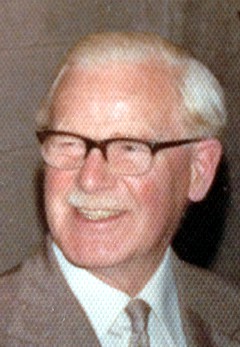 |
In 1967 we proposed a motion at the Housman AGM to desegregate all common rooms. It was defeated. The next year we did it again, and were defeated again.. But at the third attempt, in 1969, we succeeded. I was very happy to have had a small role in upholding UCL’s liberal traditions.
|
It is now quite impossible to imagine that UCL was segregated. After all, UCL was the first English university to admit women on equal terms to men, in 1878 (the Scots were a bit ahead) And UCL was home to Kathleen Lonsdale (1903 -1971), one of the first two female fellows of the Royal Society, and the first female professor at UCL. |
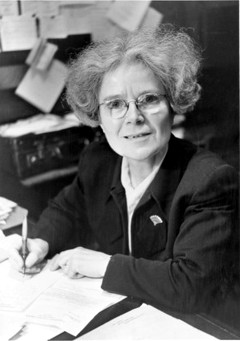 |
Nevertheless, in the mid-1960s, women were very far from being regarded as equal, even at UCL. At the time, segregation was more common than people now remember.
I was spurred to write this post when Melissa Terras, UCL’s professor of digital humanities, retweeted a reminder that it was in 1967 that a woman first ran in a an official marathon, and suffered physical attack from a male organiser for her temerity.
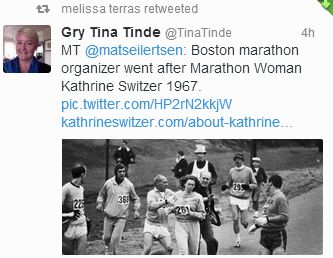
I responded

I was urged to record this history by both Terras and by Lisa Jardine, Director of UCL’s Centre for Interdisciplinary Research in the Humanities. So I have done it.

I was very aware of Kathy Switzer at the time, and I’ve no doubt she is part of the reason why I felt strongly about segregation. You can read about the 1967 Boston marathon in her own words. I thought it was a wonderful story, though I wasn’t yet into distance running myself (I was still sailing and boxing).
One of the great thing about marathons is that women and men run in the same race. That means that almost all men have had to get used to being overtaken by very many women. That has been wonderfully good for deflating male egos. When I was training for marathons in the 1980s, my training partner, Annie Briggs was on the elite start -a good hour faster than I could manage.
|
Now we are accustomed to watching Paula Radcliffe run marathons faster than any but the very best men. She’s the world record holder with the spectacular time of 2 hours 15 min in the 2003 London Marathon (my best is 3 hr 57 min). That’s only a bit over 26 consecutive 5 minute miles. And that’s faster than I could run a single mile at my peak.[Picture from Wikipedia: NYC marathon 2008 2:23:56] |
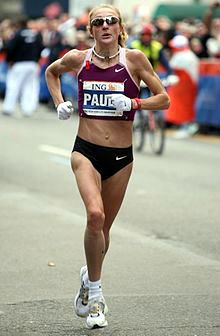 |
It’s now utterly beyond belief that in the 1960s men were saying that women were too feeble to run 26 miles. It was sheer blind arrogance. After Switzer, progress was fast. In 1972 women were allowed to run in Boston, and within 10 years, the women’s record time had fallen by a full hour. Physiology hadn’t changed, but confidence had.
Of course it wasn’t until the 2012 Olympics that women gained total equality in sport. Everyone who said that women were incapable of competing in combat sports should see Rosi Sexton in action.
She’s the ultimate high-achiever. She’s an accomplished musician (grade 7 cello, ALCM piano) and she played at the Albert Hall with the Reading Youth Orchestra. She went on to get a first in maths (Cambridge, Trinity College), where her tutor was Tim Gowers. Then she did a PhD in theoretical computer science from Manchester (read her thesis). And she’s had a distinguished career as professional athlete, competing at the highest level in MMA. Why? “The other things I did, the music, the maths, just weren’t quite hard enough“.
Not many athletes have a paper in the Journal of Pure and Applied Algebra. I’d be very happy if I could do any one of these things as well as she does.
|
It could not be more appropriate than to be writng this in the week when the Fields medal was won by a woman, Maryam Mirzakhani, for the first time since it started, in 1936. Genetics hasn’t changed since 1936. Confidence has. UCL mathematician, Helen Wilson, points out the encouragement this will give to female mathematicians. |
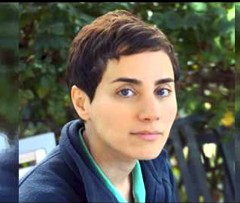 |
On 15 July 2017, Maryam Mirzakhani died, at a mere 40 years old. It’s tragic that having achieved so much, against all the odds, the dice rolled the wrong way for her, and cancer destroyed her. Her life will inspire generations to come.
As in marathons, confidence, role models and zeitgeist matter as much as genetics.
It’s examples like these that have made me profoundly suspicious of generalisations about what particular groups of people can and cannot do. Whether it is working class boys. black boys, or women, such generalisations can be shattered over a decade or two, once the zeitgeist changes.
That’s one reason that I am so unsympathetic to the IQ enthusiasts. Great harm has stemmed from the belief that it’s possible to sum up human achievements in a single number. What’s more, it’s a number that measures your resemblance to white male psychologists. It is because politicians believed the over-hyped claims of psychologists in the 1930s, that three-quarters of the population was written off. Much the same thing has happened with women, and with skin colour.
Don’t believe it.
And the job of desegregation may not be entirely finished. In fact now it is harder to combat, since it’s unspoken. Once again, I’m reminded of Peter Lawrence’s essay, The Mismeasurement of Science. Speaking of the perverse incentives and over-competitiveness that has invaded academia, he says
“Gentle people of both sexes vote with their feet and leave a profession that they, correctly, perceive to discriminate against them [17]. Not only do we lose many original researchers, I think science would flourish more in an understanding and empathetic workplace.”
The perverse incentives that make academic life hard for women (and for many men too) are administered by HR departments (with the collusion of mostly elderly male academics). They are the very same people who write fine-sounding diversity documents and lecture you about work-life balance.
It’s time they woke up.
Note. The minutes of Housman AGMs from the 1960s are missing at the moment. If they come to light, this post will be modified accordingly.
Follow-up
29 August 2014
|
As I’d hoped, this post elicited the name of one of the women who braved the rules and went into the Housman room when it was still men-only. I had an email from Lynn Bindman, and she told me that one of them was Gertrude Falk (1925 – 2008), who had worked in Bernard Katz’s Biophysics Department since 1961. |
In 1967 she must have been about 42. The episode is mentioned in Gertrude’s obituary in the Guardian. She also sent me a copy of the Physiologocal Society’s obituary, which recounts the story thus.
“Her indifference to conventions is well illustrated by the occasion when, drinking coffee in the men’s staff common room, at that time still segregated, she responded calmly to the Beadle summoned to escort her out, “well, I am certainly going to finish my coffee first”, and did so at her leisure.”
I have another story about Gertrude’s feistiness. Every year the Royal Society has a soirée for fellows and guests. It’s a sort of private view for the Summer Science exhibition. Men are required to dress like penguins despite the heat, and the invitation says “decorations will be worn”. The food is good though it’s all a bit pompous for my taste. Some years ago I met Gertrude at a soirée and I saw she was wearing a medal round her neck. I said “have they made you a Dame of the British Empire?”. She held up the medal and I saw it said “Erasmus High School Economics Prize”. She is why I usually go to the soirée wearing my London Marathon medal.
12 May 2015
Surprising as it seems now that the Housman room excluded women until 1969, there are other UCL institutions that were almost as slow as Oxford and Camridge to join the modern age.
One of these is the Professors’ Dining Club (it isn’t actually restricted to professors). I recall going to one of their dinners in the 1960s, as a guest of Heinz Otto Schild, the then head of Pharmacology, who gave me my first job. He was a lovely man, but I was horrified that it didn’t allow women to join. I recently discovered that its records reveal that it didn’t see the light until 1981. It wasn’t until after that happened that I joined the club. It seems now to be a shameful record.
Last year, I was sent my answer paper for one of my final exams, taken in 1959. This has triggered a bout of shamelessly autobiographical nostalgia.
|
The answer sheets that I wrote had been kept by one of my teachers at Leeds, Dr George Mogey. After he died in 2003, aged 86, his widow, Audrey, found them and sent them to me. And after a hunt through the junk piled high in my office, I found the exam papers from that year too. George Mogey was an excellent teacher and a kind man. He gave most of the lectures to medical students, which we, as pharmacy/pharmacology students attended. His lectures were inspirational. |
|
Today, 56 years on, I can still recall vividly his lecture on anti-malarial drugs. At the end he paused dramatically and said “Since I started speaking, 100 people have died from malaria” (I don’t recall the exact number). He was the perfect antidote to people who say you learn nothing from lectures. Straight after the war (when he had seen the problem of malaria at first hand) he went to work at the Wellcome Research Labs in Beckenham, Kent. The first head of the Wellcome Lab was Henry Dale. It had a distinguished record of basic research as well as playing a crucial role in vaccine production and in development of the safe use of digitalis. In the 1930s it had an important role in the development of proper methods for biological standardisation. This was crucial for ensuring that, for example, each batch of tincture ot digitalis had the same potency (it has been described previously on this blog in Plants as Medicines. |
|
When George Mogey joined the Wellcome lab, its head was J.W. Trevan (1887 – 1956) (read his Biographical Memoir, written by J.H. Gaddum). Trevan’s most memorable contributions were in improving the statistics of biological assays. The ideas of individual effective dose and median effective dose were developed by him. His 1927 paper The Error of Determination of Toxicity is a classic of pharmacology. His advocacy of the well-defined quantity, median effective dose as a replacement for the ill-defined minimum effective dose was influential in the development of proper statistical analysis of biological assays in the 1930s. |
Trevan is something of hero to me. And he was said to be very forgetful. Gaddum, in his biographical memoir, recounts this story
“One day when he had lost something and suspected that it had been tidied away by his secretary, he went round muttering ‘It’s all due to this confounded tidiness. It always leads to trouble. I won’t have it in my lab.’ “
|
Trevan coined the abbreviation LD50 for the median lethal dose of a drug. George Mogey later acquired the car number plate LD50, in honour of Trevan, and his widow, Audrey, still has it (picture on right). |
Mogey wrote several papers with Trevan. In 1948 he presented one at a meeting of the Physiological Society. The programme included also A.V. Hill. E.J Denton, Bernhard [sic] Katz, J.Z. Young and Richard Keynes (Keynes was George Henry Lewes Student at Cambridge: Lewes was the Victorian polymath with whom the novelist George Eliot lived, openly unmarried, and a founder of the Physiological Society. He probably inspired the medical content of Eliot’s best known novel, Middlemarch).
|
Mogey may not have written many papers, but he was the sort of inspiring teacher that universities need. He had a letter in Nature on Constituents of Amanita Muscaria, the fly agaric toadstool, which appeared in 1965. That might explain why we went on a toadstool-hunting field trip. |
The tradition of interest in statistics and biological assay must have rubbed off on me, because the answers I gave in the exam were very much in that tradition. Here is a snippet (click to download the whole answer sheet).
A later answer was about probit analysis, an idea introduced by statistician Chester Bliss (1899–1979) in 1934, as an direct extension of Trevan’s work. (I met Bliss in 1970 or 1971 when I was in Yale -we had dinner, went to a theatre -then back to his apartment where he insisted on showing me his collection of erotic magazines!)
This paper was a pharmacology paper in my first final exam at the end of my third year. The external examiner was Walter Perry, head of pharmacology in Edinburgh (he went on to found the Open University). He had previously been head of Biological Standards at the National Institute for Medical Research, a job in which he had to know some statistics. In the oral exam he asked me a killer question “What is the difference between confidence limits and fiducial limits?”. I had no real idea (and, as I discovered later, neither did he). After that, I went on to do the 4th year where we specialised in pharmacology, and I spent quite a lot of time trying to answer that question. The result was my first ever paper, published in the University of Leeds Medical Journal. I hinted, obliquely, that the idea of fiducial inference was probably Ronald Fisher‘s only real mistake. I think that is the general view now, but Fisher was such a towering figure in statistics that nobody said that straight out (he was still alive when this was written -he died in 1962).
It is well-worth looking at a paper that Fisher gave to the Royal Statistical Society in 1935, The Logic of Inductive Inference. Then, as now, it was the custom for a paper to be followed by a vote of thanks, and a seconder. These, and the subsequent discussion, are all printed, and they could be quite vicious in a polite way. Giving the vote of thanks, Professor A.L. Bowley said
“It is not the custom, when the Council invites a member to propose a vote of thanks on a paper, to instruct him to bless it. If to some extent I play the inverse role of Balaam, it is not without precedent;”
And the seconder, Dr Isserlis, said
“There is no doubt in my mind at all about that, but Professor Fisher, like other fond parents, may perhaps see in his offspring qualities which to his mind no other children possess; others, however, may consider that the offspring are not unique.”
Post-publication peer review was already alive and well in 1935.
I was helped enormously in writing this paper by Dr B.L.Welch (1911 – 1989), whose first year course in statistics for biologists was a compulsory part of the course. Welch was famous particularly for having extended Student’s t distribution to the case where the variances in two samples being compared are unequal (Welch, 1947). He gave his whole lecture with his back to the class while writing what he said on a set of blackboards that occupied the whole side of the room. No doubt he would have failed any course about how to give a lecture. I found him riveting. He went slowly, and you could always check your notes because it was all there on the blackboards.
Walter Perry seemed to like my attempt to answer his question, despite the fact that it failed. After the 4th year final (a single 3 hour essay on drugs that affect protein synthesis) he offered me a PhD place in Edinburgh. He was one of my supervisors, though I never saw him except when he dropped into the lab for a cigarette between committee meetings. While in Edinburgh I met the famous statistician. David Finney, whose definitive book on the Statistics of Biological Assay was an enormous help when I later wrote Lectures on Biostatistics and a great help in getting my first job at UCL in 1964. Heinz Otto Schild. then the famous head of department, had written a paper in 1942 about the statistical analysis of 2+2 dose biological assays, while interned at the beginning of the war. He wanted someone to teach it to students, so he gave me a job. That wouldn’t happen now, because that sort of statistics would be considered too difficult Incidentally, I notice that Schild uses 99% confidence limits in his paper, not the usual 95% limits which make your results look better
It was clear even then, that the basis of statistical inference was an exceedingly contentious matter among statisticians. It still is, but the matter has renewed importance in view of the crisis of reproducibility in science. The question still fascinates me, and I’m planning to update my first paper soon. This time I hope it will be a bit better.
Postscript: some old pictures
While in nostalgic mood, here are a few old pictures. First, the only picture I have from undergraduate days. It was taken on a visit to May and Baker (of sulphonamide fame) in February 1957 (so I must have been in my first year). There were 15 or so in the class for the first three years (now, you can get 15 in a tutorial group). I’m in the middle of the back row (with hair!). The only names that I recall are those of the other two who went into the 4th year with me, Ed Abbs (rightmost on back row) and Stella Gregory (2nd from right, front row). Ed died young and Stella went to Australia. Just in front of me are James Dare (with bow tie) and Mr Nelson (who taught old fashioned pharmacognosy).
|
James Dare taught pharmaceutics, but he also had a considerable interest in statistics and we did lots of calculations with electromechanical calculators -the best of them was a Monroe (here’s a picture of one with the case removed to show the amazingly intricate mechanism). |
>
Monroe 8N-213 from http://www.science.uva.nl/museum/calclist.php |
The history of UCL’s pharmacology goes back to 1905. For most of that time, it’s been a pretty good department. It got top scores in all the research assessments until it was abolished by Malcolm Grant in 2007. That act of vandalism is documented in my diary section.
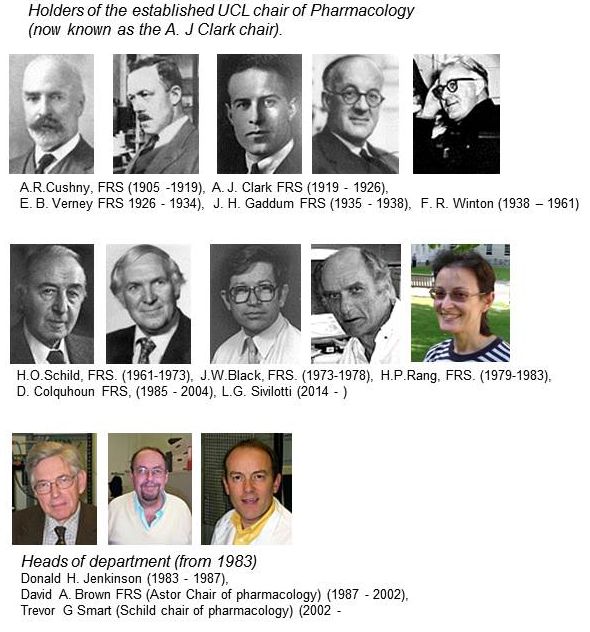
For most of its history, there was one professor who was head of the department. That tradition ended in 1983,when Humphrey Rang left for Novartis. The established chair was then empty for two years, until Donald Jenkinson, then head of department, insisted with characteristic modesty, that I rather than he should take the chair. Some time during the subsequent reign of David Brown, it was decided to name the chairs, and mine became the A.J. Clark chair. It was decided that the headship of the department would rotate, between Donald, David Brown and me. But when it came to my turn, I decided I was much too interested in single ion channels to spend time pushing paper, and David Brown nobly extended his term. The A.J. Clark chair was vacant after I ‘retired’ in 2004, but in 2014, Lucia Sivilotti was appointed to the chair, a worthy successor in its quantitative tradition.
The first group picture of UCL’s Pharmacology department was from 1972. Heinz Schild is in the middle of the front row, with Desmond Laurence on his left. Between them they dominated the textbook market: Schild edited A.J. Clark’s Pharmacology (now known as Rang and Dale). Laurence wrote a very successful text, Clinical Pharmacology. Click on the picture for a bigger version, with names, as recalled by Donald Jenkinson: (DHJ). I doubt whether many people now remember Ada Corbett (the tea lady) or Frank Ballhatchet from the mechanical workshop. He could do superb work, though the price was to spent 10 minutes chatting about his Land Rover, or listening to reminiscences of his time working on Thames barges. I still have a beautiful 8-way tap that he made. with a jerk-free indexing mechanism.
The second Departmental picture was taken in June 1980. Humphrey Rang was head of department then. My colleagues David Ogden and Steven Siegelbaum are there. In those days we had a tea lady too, Joyce Mancini. (Click pictures to enlarge)



